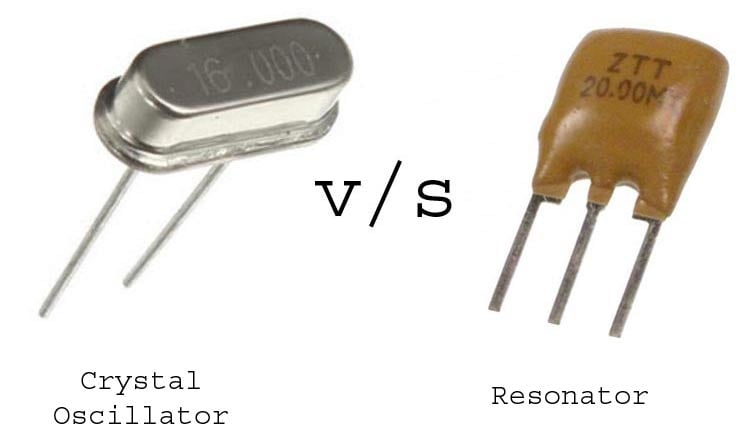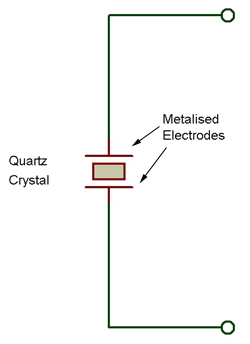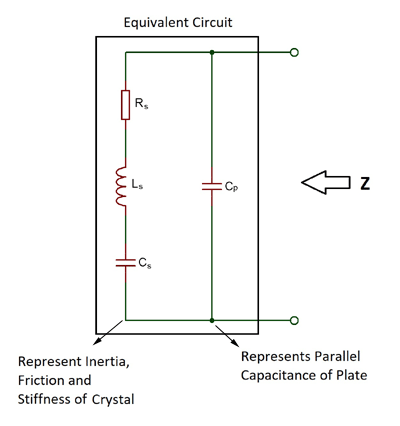
There are various resonators that are used for an immense number of applications in the field of Electronics. In those list of resonators, the two mainly used materials are quartz crystal and Ceramic (making Ceramic Resonator). Quartz crystal is used in Crystal Oscillator and Ceramic is used in Ceramic Resonator. Both of them have the same aim of generating an oscillation frequency by vibrating when an input voltage is given to them. But they two have some differences too, which separates them & as a result, they have different applications.
What is Crystal Oscillator?
An oscillator is a circuit that generates frequency with the help of a tuned circuit & that generated frequency is known as oscillating frequency. Similarly, a crystal oscillator is an electronic circuit or device which is used to generate a stable frequency with the help of a crystal instead of a tuned circuit. The crystal when vibrates, it acts like a resonator & as a result generates an oscillated frequency. The resonator circuit uses a crystal to generate the oscillation, led to the name as Crystal Oscillator. The symbol & circuit of a crystal oscillator is as shown below:


Learn more about Quartz crystal and crystal oscillator here.
What is a Ceramic Resonator?
Similar to the Crystal Oscillator, Ceramic Resonator is also an electronic circuit or a device used to generate an output of oscillation frequency with the help of Ceramic as a resonating piezoelectric material. The material can have two or more electrode which when connected to an oscillator circuit gets mechanical vibration & as a result an oscillating signal of a specific frequency is generated. The circuit for the resonator is similar to that of Crystal Oscillator and is as shown below:

When the resonator is working, the mechanical vibrations produce an oscillating voltage due to the piezoelectric material i.e. ceramic and the oscillating voltage is then attached to the electrodes as output. The inverse concept is used in case of inverse Piezoelectric effect.
Crystal Oscillator Vs Resonator
Though they both have the same working procedure & generate frequency oscillation as output, they have some difference in properties due to which the oscillator has replaced resonator in many cases, which are:
- Frequency Range - The Crystal Oscillator has much high Q factor than that of Ceramic Resonator due to which Crystal Oscillator has a frequency range of 10 kHz – 100 MHz range while the frequency range of ceramic resonator varies from 190 kHz – 50 MHz
- Output - Crystal Oscillator provides high stability frequency output and the Ceramic resonator also provides stability output not that good as compared to Crystal Oscillator. In terms of output frequency accuracy, Crystal Oscillator provides much more accurate output than the Ceramic resonator for which parameters like temperature are a sensitive element. The accuracy for the oscillator is 10ppm-1000ppm while for the resonator is 0.1% - 1%.
- Effect due to Parameters - For Ceramic resonator, the thickness of the ceramic material would determine the output resonant frequency while for Crystal Oscillators the resonant frequency output depends on the size, shape, elasticity & speed of sound in the material. The Crystal Oscillator has very low dependency on temperature i.e. they are highly stable even with changes in temperature and the ceramic resonator have a little more dependency on temperature then Crystal Oscillator. For a Quartz Crystal Oscillator, the output characteristics depends on the vibration mode and angle at which the crystal is cut while in resonator mainly the thickness matters.
- Tolerance & Sensitivity - The Crystal Oscillator has less tolerance against shock & vibration while the ceramic resonator has a high tolerance comparatively. Crystal oscillator has low ESD (Electrostatic Discharge) tolerance while the ceramic resonator has a high ESD tolerance. Oscillators are more sensitive than the resonators, the sensitivity can be compared in terms of radiation. Quartz has a 0.001% frequency tolerance, while PZT has a 0.5% tolerance.
- Capacitor Dependency - Resonators may have internal capacitors or need external ones sometimes while the Oscillator needs external capacitors and their value depends on what crystal is designed to work with.
- Material Used - Crystal Oscillator is made up of Quartz as the piezoelectric resonator material while Ceramic resonators are made of Lead Zirconium Titanate (PZT), which is known as high stability piezoelectric ceramic material. Crystal Oscillator is difficult to manufacture while the ceramic resonator are easy to manufacture.
- Applications – Ceramic resonators are used in microprocessor application where the frequency stability is not important while Crystal Oscillator can be found in everything from televisions to children’s toys that have electrical components. Resonators are good for low-speed serial port communication while the crystal oscillators have frequencies available to support high-speed serial communications also. The resonators do not have frequencies available for high-speed serial port communications. In terms of clock based applications, Resonators are not very suitable for a Real-Time Clock/timekeeping/wall clock while oscillators may be suitable for timekeeping/RTC/wall clock if tuned with a variable capacitor, expect few minutes drift per year if not tuned.





